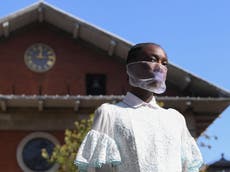The Independent's journalism is supported by our readers. When you purchase through links on our site, we may earn commission.
Digital fashion weeks have forced the industry to confront some difficult questions
Fashion has suffered greatly as a result of the pandemic, while the impact of Brexit on supply chains will last for years – but digitally streamed fashion week is long overdue

I had an unrealistic introduction to London Fashion Week. It was a decade ago this year that I attended my first show, Giles Deacon’s SS12 collection, which he presented at the Royal Courts of Justice in September 2011. I bagged a spot at the end of the runway and as the models marched the length of the gothic central hall, it felt as though they were walking just for me (and not the baying paparazzi perched on step ladders in the pit to my left).
The collection had a palette of white, silver and camel, injected with shots of red. Silver tasselled leather skirts appeared electric, feathered boleros, epaulettes and hems moved like pampas grass in the wind. I was 22 and transfixed. The final looks had the models in life-size swan headdresses, all the more poignant for our proximity to the Royal Opera House. The performance elicited the same response in me as watching a live ballet.
It was unrealistic because I’d spend the next few seasons crammed into the back row of shows, craning my neck to catch a glimpse of a collection that I was expected to review in detail, before I was considered important enough to be granted the honour of a ticketed seat (the politics of seating at fashion week is the stuff of infamy).
I’ve since attended hundreds of fashion shows hosted in museums, government buildings, warehouses, music halls and skate parks. For a decade it has been a work requirement for me to attend fashion week, but it is also an immense privilege. The tickets have given me access to an elite world of celebrity front rows, supermodels backstage and close-ups of garments that would end up behind glass in museums.
Catwalk shows have brought tears to my eyes on more than one occasion. Cheesy, perhaps; embarrassing to admit, certainly. But fashion is about fantasy and possibility and fashion shows suspend you in the designer’s imagined world – the dream we buy into with every purchase. They combine music, choreography, art, performance – it is the theatre of fashion.
Fashion shows are as important to the industry as a tour is for a musician, as a premiere or festival is for film. It is a chance for designers’ creations to come to life and be seen by the people who determine their success.
In the past decade in particular, fashion week has spiralled into a global circus that sees models, editors, buyers and influencers fly between the four major cities – London, Paris, Milan and New York – then be chauffeured from show to show. Fashion week has become bigger than clothes. Designers have spent as much as $300,000 to put on a show as the pressure to create a memorable, Instagrammable moment became monumental. The 2014 documentary Dior and I provides excellent insight into the immense stress of this.
Covid ran an electric convulsive shock through the industry, forcing it to change tack and adapt to digital-only fashion weeks, streamed online for anyone to watch.
The industry has suffered greatly as a result of the pandemic, while the impact of Brexit on supply chains will last for years to come. Many brands have been forced to close. But digitally streamed fashion week is long overdue.
Not only more cost effective, digital fashion weeks are more democratic to both attendees (anyone can watch; we all have front row seats) and fledging brands who no longer have to fork out for the costs of a major production. And of course, there’s the immediate reduction of the carbon footprint of the attendees. According to a report by Orde in association with the Carbon Trust, the total carbon emissions of travel required for the ready-to-wear shows accounts for 241,000 tons of CO2 a year.
The jury is still out about whether digital shows are cheaper overall (many fashion brands created full-on productions last season) and how much greener it really is (the travel of models, crew and hair and make-up remains necessary and the carbon emissions of digital streaming are high).
We now have a chance to improve fashion week. In future, we must combine streaming with physical shows, and open the door of an elite industry that should be more widely accessible (Burberry has been streaming their shows for a while now, allowing fans an insight into the brand they love).
There are some elements of fashion weeks that cannot be replicated online, though. They have often been the target of protesters, with animal rights groups, body positivity campaigners and environmentalists like Extinction Rebellion all protesting outside shows. Without a physical hub, where can protesters have their valid concerns heard? Fashion week provides a platform for these and many other advances the industry needs to see. The best way to incite change is to be out in the open – much of the problem with the industry is the lack of visibility of supply chains and decision making.
Many designers were embracing digital streaming long before the pandemic to increase their global audiences. But the power of a real-life show remains – Covid has taught us the human need for physical events.
Much needs to change about the fashion industry. The elite circus of fashion week can’t return to the pre-Covid way and many brands simply won’t be able to afford it any longer. But ultimately sitting in your trackies watching a fashion production from the sofa isn’t the same as seeing the three-dimensional production play out in front of you.
There’s nothing quite like the impact of attending a fashion show and the spectacle of the runway will exist long after Covid.






Join our commenting forum
Join thought-provoking conversations, follow other Independent readers and see their replies